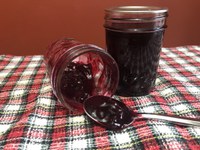Dakota Gardener: Fruit for Thought
(Click an image below to view a high-resolution image that can be downloaded)
This summer I picked sour cherries at a fellow gardener’s home. I had not picked sour cherries before and this year was a bumper crop. I wanted two ice cream pails and left with five! The cherries were a bit sour for my taste buds, but once those tart fruits were pitted and turned into jam, they were a culinary delight.
Sour cherries add beauty and color to the landscape with flowers in the spring and interesting bark and fruits in the summer and fall. The breeding of Dwarf Sour cherries began in the late 1940s by Les Kerr at the University of Saskatchewan.
Sour cherries are self-fruitful and do not need another variety nearby to produce fruit. They need direct sunlight for at least half the day, but more sunlight is always better.
It is recommended to plant the shrubs a few inches deeper than they were in the original container. The extra buds at the soil surface serve as a safety net incase something happens to the upper part of the plant. Deer and rabbit damage is an example. Older stems or trunks also can be victim to winter kill, which is irreversible damage due to winter conditions.
Sour cherries prefer well-drained soils and will need irrigation the first few years of their establishment. After that, plants are able to withstand drier conditions. Be sure to keep competing grass and weeds away from the shrubs when they are young. Mulch can be used to help reduce weed competition and help conserve soil moisture.
These shrubs don’t need fertilizer, but if you choose to add fertilizer, do so in the early spring as growth is emerging.
Sour cherries can grow six feet tall or more, so be sure to read the plant information carefully. The shrubs need their space for suckers to form multiple stems or trunks. Shrubs will produce cherries once they are 4 or 5 years old.
Do not harvest the cherries when they first turn red. The cherries need time to mature and develop a sweeter flavor. Instead, wait to harvest the cherries when they have reached a deep rich color. Mature cherries will not fall from the branches. Depending on growing conditions and cultivars, shrubs can yield 25 to 30 pounds or more of fruit.
Recommended cultivars for eating are Carmine Jewel, Romeo, Valentine, Crimson Passion, Juliet and Cupid. Carmine Jewel and Valentine are great for processing while Juliet is best for fresh eating.
For more information on sour cherries, visit the University of Saskatchewan Fruit Program website at https://research-groups.usask.ca/fruit/Fruit%20crops/sour-cherries.php
Needless to say, these beautiful and flavorful tart treats made my planting list for the upcoming year. Now, I just need to find the space.
Happy gardening!
NDSU Agriculture Communication - Nov. 2, 2021
Source: Carrie Knutson, 701-780-8229, carrie.knutson@ndsu.edu
Editor: Kelli Anderson, 701-231-6136, kelli.c.anderson@ndsu.edu




